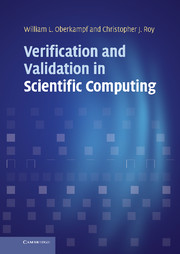Book contents
- Frontmatter
- Contents
- Preface
- Acknowledgments
- 1 Introduction
- Part I Fundamental concepts
- Part II Code verification
- Part III Solution verification
- Part IV Model validation and prediction
- 10 Model validation fundamentals
- 11 Design and execution of validation experiments
- 12 Model accuracy assessment
- 13 Predictive capability
- Part V Planning, management, and implementation issues
- Appendix Programming practices
- Index
- Plate Section
- References
10 - Model validation fundamentals
from Part IV - Model validation and prediction
Published online by Cambridge University Press: 05 March 2013
- Frontmatter
- Contents
- Preface
- Acknowledgments
- 1 Introduction
- Part I Fundamental concepts
- Part II Code verification
- Part III Solution verification
- Part IV Model validation and prediction
- 10 Model validation fundamentals
- 11 Design and execution of validation experiments
- 12 Model accuracy assessment
- 13 Predictive capability
- Part V Planning, management, and implementation issues
- Appendix Programming practices
- Index
- Plate Section
- References
Summary
Because of the well-developed methodologies and techniques developed in metrology, experimental measurements are usually viewed as the best way to estimate a true value, if one exists. This level of trust and credibility in experimental measurements has been built over at least four millennia of learning, both from mistakes and successes. This is not meant to imply that experimental measurements always yield an accurate estimate of the true value. Experimental measurements can be inaccurate, or downright wrong, for many reasons. What is meant by the trustworthiness of an experimental measurement is that techniques for investigating its limitations, weaknesses, and uncertainties are generally well understood. When new experimental diagnostic techniques are developed they must be carefully investigated and understood. Where possible, comparisons need to be made with measurements from existing, better understood, techniques so that measurement uncertainty can be better quantified. As science and technology progresses, new measurement techniques can increase the confidence in measurement accuracy and also begin to measure physical quantities that were previously immeasurable.
An enlightening way of thinking about the trustworthiness of experimental measurements is to think of an experimental measurement as “asking a question of nature” (Hornung and Perry, 1998). When a measurement result is obtained, the result can be thought of as nature's answer to a question we have asked. We tend to believe that the answer obtained is the answer to the question we think we asked. However, this is not actually the case because there are always assumptions involved on our part. For example, when we measure the fluid velocity in a flow field, we believe we asked the question: given the flow field of interest, what is the velocity of the fluid at a certain point? Our intent is to ask nature the question that excludes or minimizes the effect of random or systematic errors in the measurement. If, however, there is significant random measurement error or if there is an unknown systematic error either in the measurement itself or in the data reduction procedure, then the question asked of nature is different from what we thought we asked. That is, nature answered the question that includes the random and systematic errors, whether large or small.
- Type
- Chapter
- Information
- Verification and Validation in Scientific Computing , pp. 371 - 408Publisher: Cambridge University PressPrint publication year: 2010



